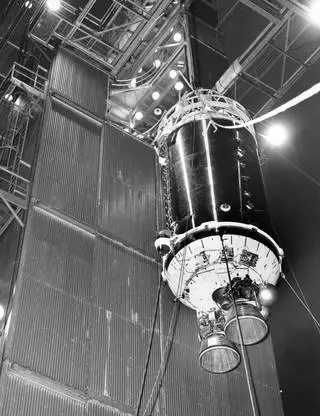A relic of the 1960s Space Race may be paying Earth a brief visit with NASA announcing that a rocket booster from the 1966 Surveyor 2 robotic Moon lander mission is suspected to have returned from deep space and taken up temporary orbit around the Earth.
While the space agencies like to keep an eye on where their deep-space probes are even after they've gone inactive, they're not as interested in what happens to the rockets that launched those probes into space. So long as they burn up in the Earth's atmosphere, crash into the ocean, or fly off into the depths of space and don't pose a hazard, they're just expendable hardware.
That is, until they do something unexpected. On September 20, 1966, NASA launched the Surveyor 2 lander toward the Moon in the hope that it would be the second US successful soft landing on the lunar surface after Surveyor 1. The Atlas Centaur booster worked as planned, putting the spacecraft right where it should have been over Sinus Medii, but a thruster malfunction threw the lander into a hopeless tumble and it crashed near Copernicus crater.
Meanwhile, the Centaur rocket upper stage flew past the Moon as planned and went into orbit around the Sun. That should have been the end to the story, but in September 2020, the NASA-funded Pan-STARRS1 survey telescope on the island of Maui in Hawaii picked up an object moving in an arc in the sky, which indicated that it was near the Earth.

According to NASA, the astronomers dismissed it as a small asteroid and given a standard designation of 2020 SO by the Minor Planet Center in Cambridge, Massachusetts. However, the scientists at the Center for Near-Earth Object Studies (CNEOS) at NASA's Jet Propulsion Laboratory in Southern California had other ideas.
The orbit of 2020 SO wasn't like that of an asteroid. Instead of being elongated and tilted against the plane of the ecliptic, its trajectory was almost circular and right in the plane. Furthermore, the pressure of sunlight was shifting its orbit, indicating that it was very light. Since an empty booster rocket is basically an empty tube made out of very light metal alloys, that was the obvious candidate.
CNEOS Director Paul Chodas then took the calculated orbit and ran it backwards in time, discovering that 2020 SO had passed the Earth several times, and in 1966 it was so close that it could have been launched from the Earth at a date corresponding to Surveyor 2.
NASA says that on November 8, 2020, the object entered into the Hill sphere, which has a radius of about 930,000 miles (1.5 million km), and marks the area of Earth's gravitational dominance. This has brought 2020 SO into a temporary orbit around the planet, which will last until about March 2021, when it will go back to orbiting the Sun.
Until then, 2020 SO will make a close flyby of the Earth on December 10, 2020, when astronomers will make a spectroscopic analysis to determine its composition and, possibly, confirm that it is indeed the long-lost rocket.
The animation below shows the temporary orbit of 2020 SO.
Source: NASA





